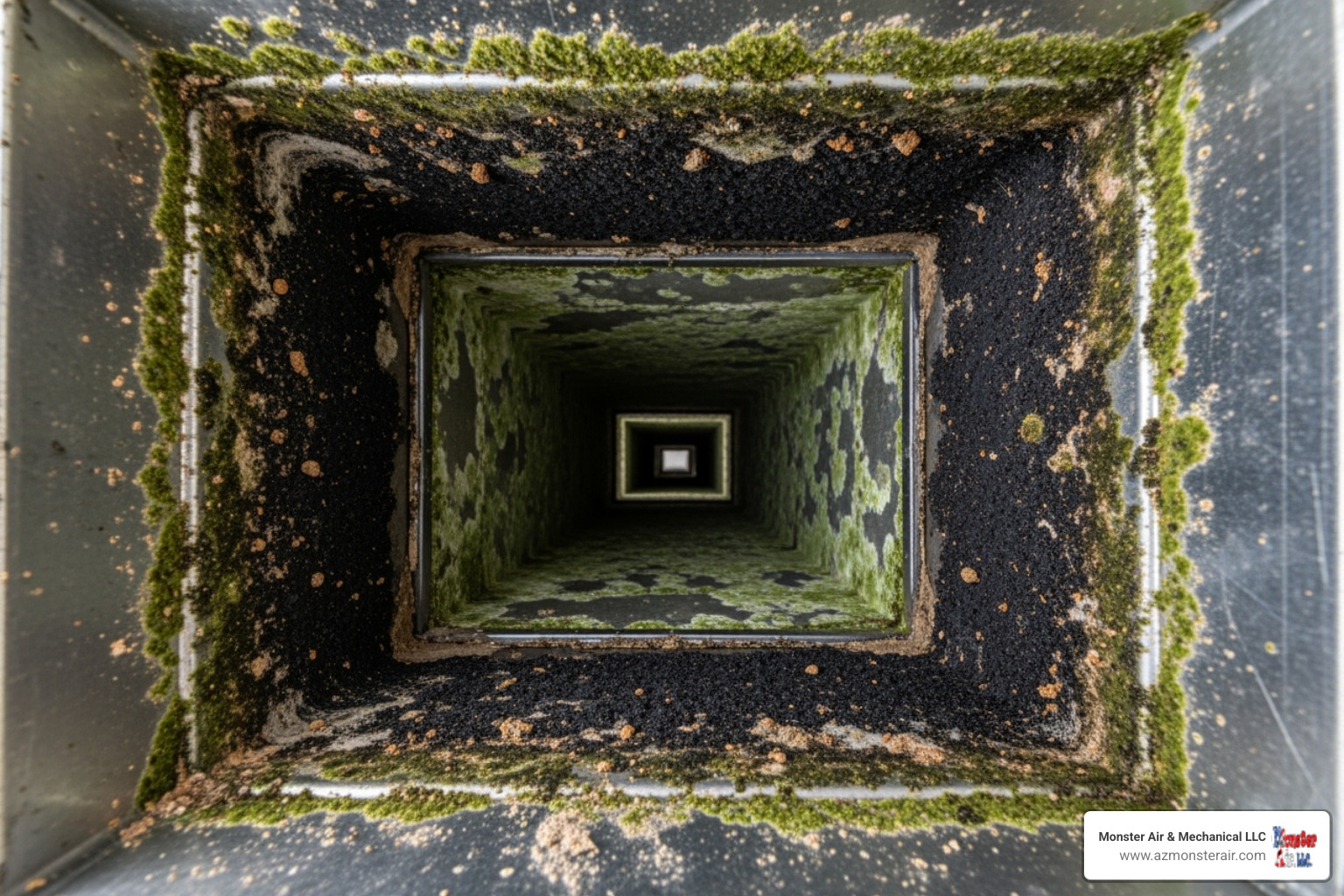Why Commercial HVAC Ductwork is the Backbone of Your Building
Commercial HVAC ductwork is the network of channels that moves conditioned air from your heating and cooling equipment throughout your building. Here's what you need to know:
- Primary Function: Distributes heated or cooled air from HVAC units to different zones and returns stale air back for reconditioning
- Main Types: Rectangular (space-efficient), Round/Spiral (superior airflow), and Flexible (easy installation in tight spaces)
- Common Materials: Galvanized steel, aluminum, stainless steel, fiberglass, and polyurethane foam
- Key Benefits: Maintains consistent temperatures, reduces energy consumption, and improves indoor air quality
- Critical Components: Plenums, diffusers, registers, dampers, transitions, seals, and fire dampers
Think of ductwork as your building's circulatory system, delivering conditioned air to every corner. This critical infrastructure often goes unnoticed—hidden above ceilings and behind walls—until something goes wrong.
Properly designed and installed ductwork is essential for consistent temperatures, lower energy use, and occupant comfort. When it fails, energy bills climb, air quality suffers, and your HVAC equipment is overworked.
Well-sealed ducts prevent air leaks, minimizing energy waste and lowering utility costs. Clean ductwork prevents the buildup of dust and allergens, creating a healthier indoor environment. Understanding your ductwork helps you make informed decisions about maintenance, repairs, and upgrades for any commercial facility.
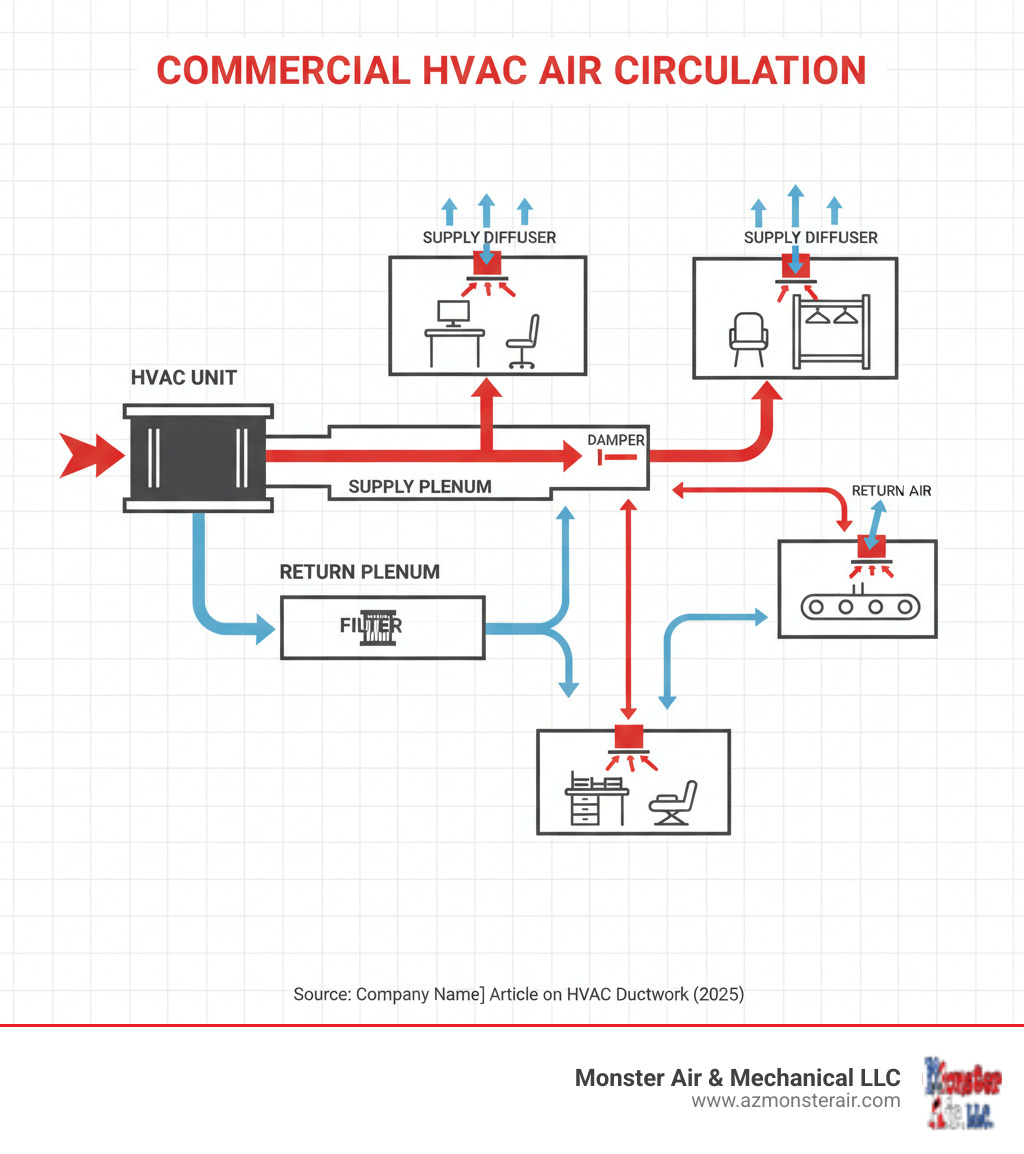
Key Types of Commercial HVAC Ductwork and Materials
Choosing the right commercial HVAC ductwork isn't just about picking pipes; it's about creating an efficient system that matches your building's unique needs. The shape and material you select will affect everything from airflow quality to energy bills.
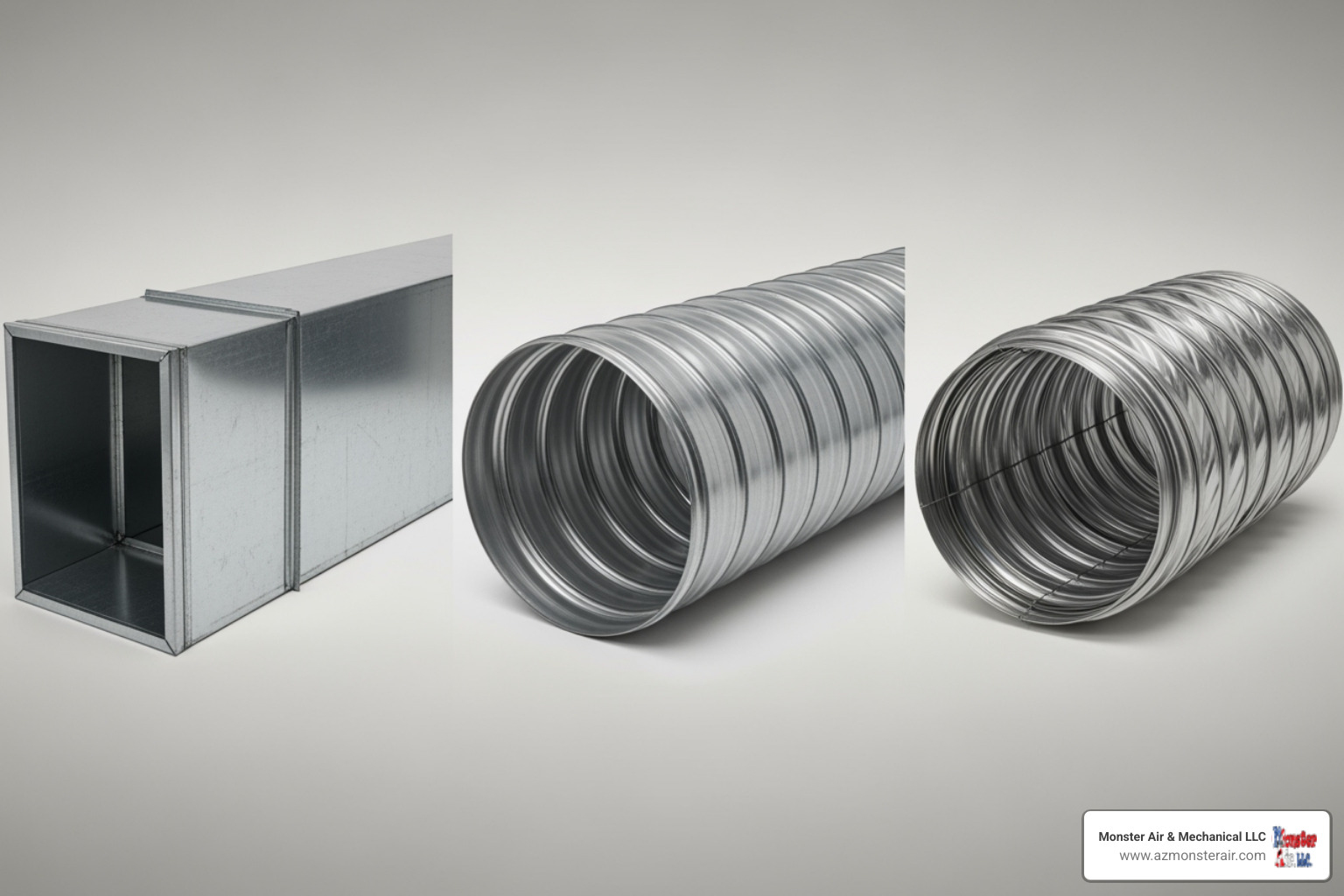
Common Ductwork Shapes: Pros and Cons
Commercial buildings typically use one of three main duct shapes, each with a specific purpose.
| Feature | Rectangular Ductwork | Round/Spiral Ductwork | Flexible Ductwork |
|---|---|---|---|
| Airflow Efficiency | Can have higher air resistance and noise due to corners | Superior airflow, less resistance, quieter operation | May restrict airflow, prone to damage if not installed correctly |
| Space Requirements | Ideal for spaces with limited ceiling height | Requires more vertical space, but can be aesthetically exposed | Highly versatile, fits into tight or awkward spaces |
| Installation Ease | Generally easy to fabricate and install, but can be bulky | Less susceptible to air leakage, often quicker to install (spiral) | Very easy to install, ideal for retrofitting |
| Ideal Application | Commercial spaces with height constraints (e.g., offices) | High-velocity systems, industrial facilities, exposed aesthetics | Retrofitting, connecting rigid ducts, areas with limited access |
Rectangular ducts are common in office buildings because their flat sides fit well in tight ceiling spaces. While easy to fabricate and install, their sharp corners can create turbulence, reducing airflow efficiency and increasing noise.
Round and spiral ducts are efficiency champions. Their circular shape allows air to flow with minimal resistance, and they seal better than rectangular ducts, reducing leaks. Often seen in industrial or modern spaces with exposed aesthetics, they require more vertical clearance but offer superior performance.
Flexible ducts are problem-solvers for tricky spaces, bending around obstacles where rigid ducts can't fit. They are ideal for retrofitting or making final connections. However, to maintain good airflow, it's crucial to keep runs short and avoid sharp bends or compression, as flexible ducts may restrict airflow.
Essential Materials Used in Fabrication
The material you choose for your commercial HVAC ductwork determines its longevity and performance in your specific environment.
Galvanized steel is the industry standard. Its zinc coating prevents rust, making it a durable and cost-effective choice for most commercial environments.
Aluminum is a lightweight, corrosion-resistant alternative to steel. It's ideal for humid environments and situations where reduced weight can speed up installation.
Stainless steel is the premium choice for demanding environments like medical facilities or food processing plants. Its non-porous, corrosion-resistant surface resists bacteria and mold, ensuring hygiene and extreme durability.
Fiberglass duct board provides both an air channel and insulation. It prevents thermal loss and absorbs sound, leading to quieter operation and consistent air temperatures.
Polyurethane panels are pre-insulated and offer superior thermal performance. They minimize energy loss by keeping conditioned air at the correct temperature, streamlining installation and boosting efficiency.
Anatomy of a Commercial Ductwork System: Core Components and Accessories
Understanding the parts of your commercial HVAC ductwork system is key to appreciating how it delivers comfort and maintains air quality. Each component has a specific job to keep your building comfortable, safe, and energy-efficient.
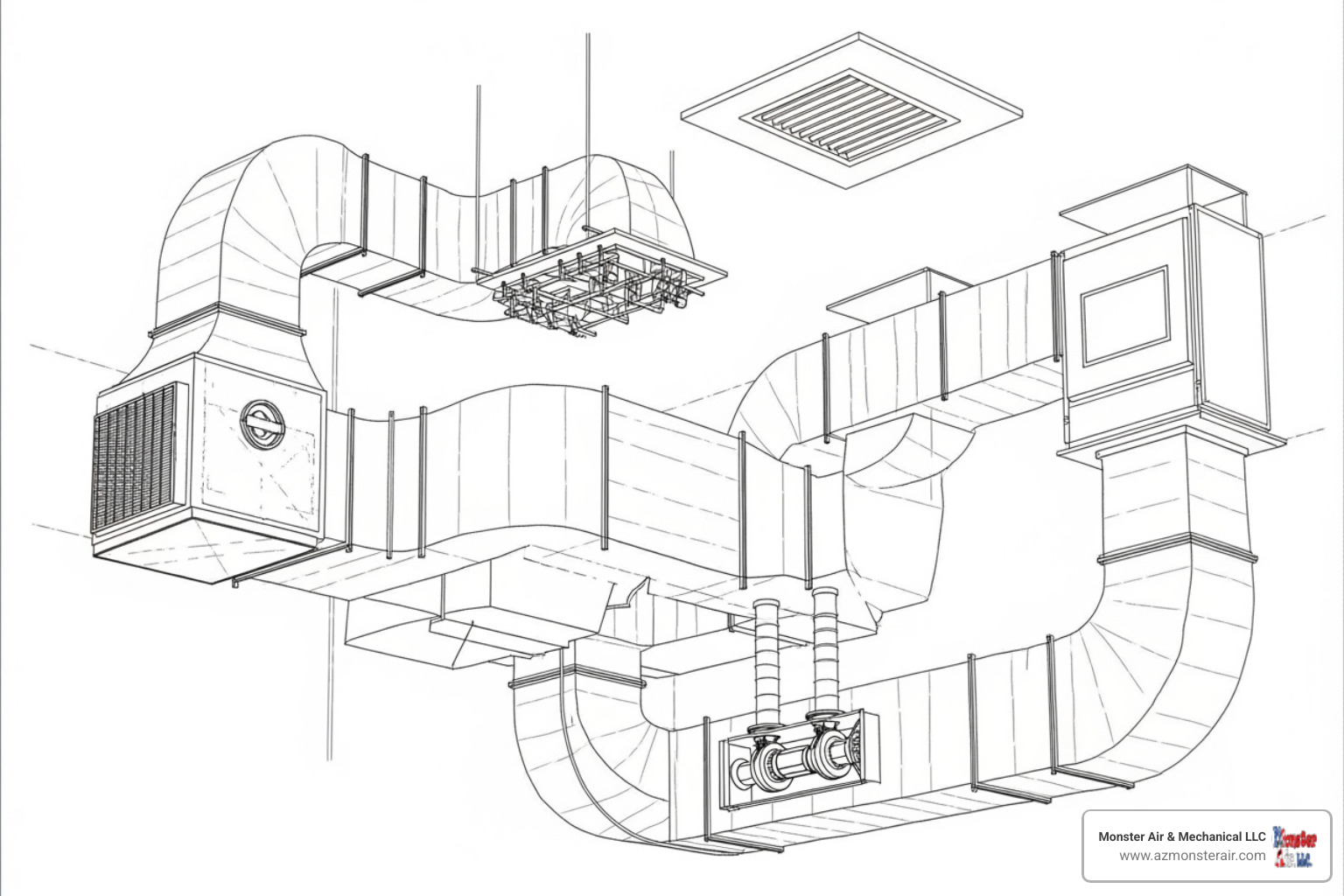
Essential Components of a Commercial HVAC Ductwork System
Every component plays a vital role in your system's performance.
Plenums are large air distribution boxes connected to the HVAC unit. They act as a central hub, gathering conditioned air for supply ducts and collecting return air for reconditioning.
Diffusers, registers, and grilles are the visible outlets of your ductwork. Diffusers mix supply air evenly to prevent drafts. Registers often have dampers to control airflow. Grilles handle return air. The design and placement of these components significantly impact comfort.
Take-offs are branching connections that split air from a main duct to smaller ducts, delivering air to individual rooms. Proper design is crucial to ensure balanced airflow.
Transitions and connectors adapt ductwork shape or size, such as changing from rectangular to round. They ensure smooth, efficient airflow when the duct path changes or steers obstacles.
Seals and joints are critical for efficiency. Every connection must be sealed to prevent air leakage, which wastes energy and drives up costs. We adhere to SMACNA standards to ensure airtight, durable connections. Well-sealed ducts are essential for minimizing energy waste.
Critical Accessories for Safety and Maintenance
Beyond core components, several accessories are essential for safety, efficiency, and maintenance.
Access doors are small panels in the ductwork that provide crucial access for inspection, cleaning, and maintenance. They are indispensable for maintaining long-term air quality and system performance.
Vibration isolators are installed between the HVAC unit and ductwork to reduce noise and vibration transfer into the building, contributing to a quieter, more comfortable environment.
Fire dampers and smoke dampers are vital life-safety devices. Fire dampers automatically close to prevent the spread of flames, while smoke dampers contain smoke and toxic fumes. Building codes mandate their use where ducts pass through fire-rated walls or floors.
Volume control dampers (VCDs) are adjustable plates inside ducts that regulate airflow to different building sections. They are essential for balancing the system to ensure each zone receives the correct amount of conditioned air.
Here are the essential accessories every commercial ductwork system needs:
- Access doors for inspection and maintenance
- Vibration isolators to reduce noise transfer
- Fire dampers to prevent flame spread
- Smoke dampers to contain toxic fumes
- Volume control dampers for airflow regulation
These components work silently behind the scenes, keeping your building comfortable, healthy, and protected.
How Ductwork Design Impacts Efficiency, Air Quality, and Comfort
The design of your commercial HVAC ductwork is more than moving air; it's a system that directly affects your energy bills, occupant health, and comfort. Proper design means an efficient, quiet system, while poor design wastes money and causes discomfort.
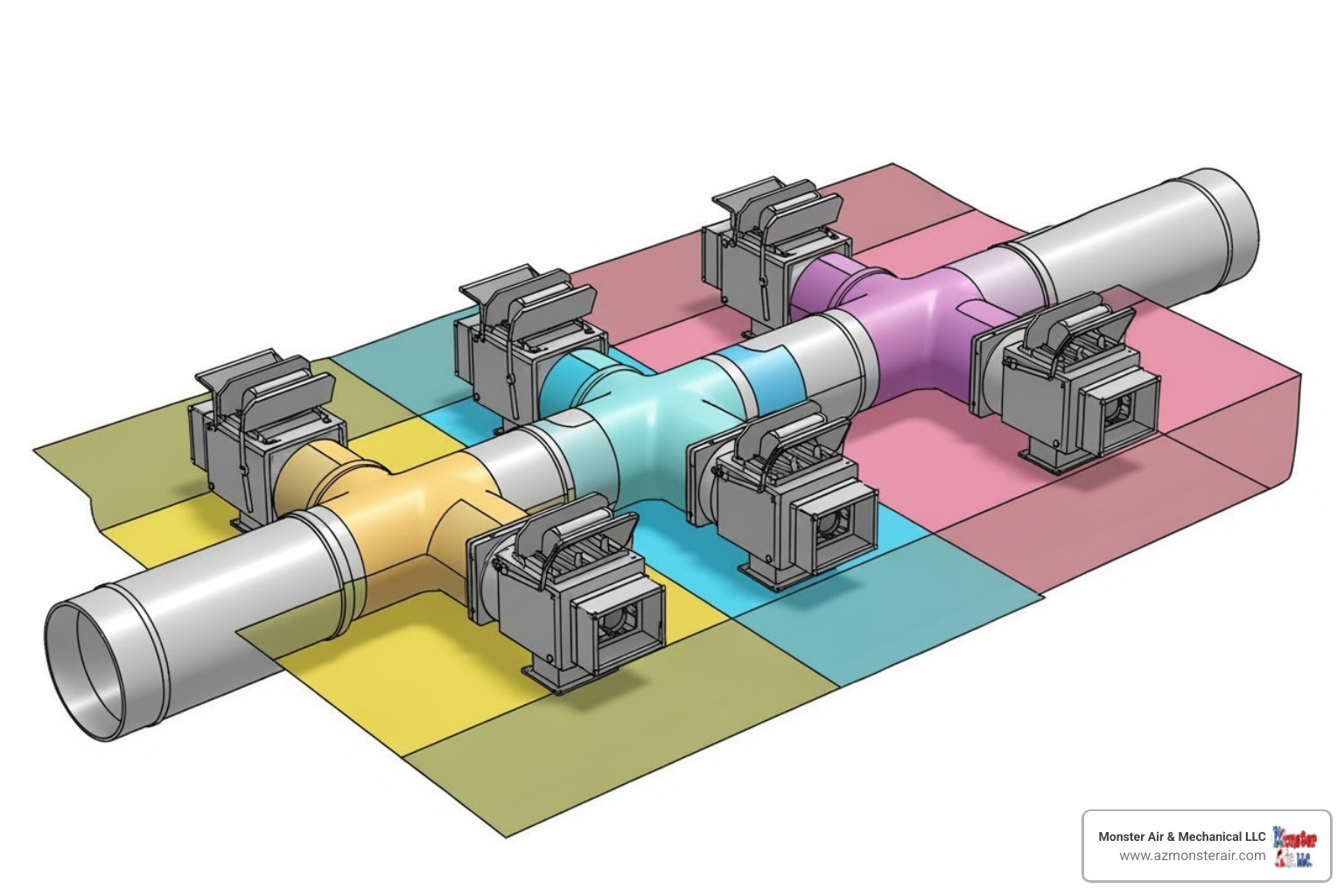
The Link Between Ductwork, Energy Efficiency, and IAQ
Properly designed ductwork is a comfort delivery system that maintains consistent temperatures and controls energy costs.
Proper sizing is critical. Ducts that are too small force the HVAC system to work harder, wasting energy. Ducts that are too large cause poor circulation. Correct sizing ensures efficient air delivery.
Air leaks are silent energy thieves. Poorly sealed ductwork can lose 20-30% of conditioned air, wasting money and energy. Well-sealed ducts prevent these leaks, minimizing energy waste and lowering utility costs.
Insulation is also critical, especially for ducts in unconditioned spaces. Without it, conditioned air loses temperature, forcing the system to run longer. Quality insulation reduces thermal loss and prevents condensation and mold growth.
Your ductwork system also has a massive impact on indoor air quality. The Environmental Protection Agency (EPA) defines indoor air quality (IAQ) as the air quality within and around buildings as it relates to occupant health and comfort. Clean ductwork prevents the circulation of dust and allergens. Leaky ducts pull in unfiltered air and contaminants from spaces like attics or wall cavities, distributing them throughout your building.
Choosing the Right Commercial HVAC Ductwork for Your Application
There is no one-size-fits-all solution for commercial HVAC ductwork. The right choice depends on the building's unique needs:
- Building size and layout are key. A small retail shop may use rectangular ducts, while a large warehouse benefits from round or spiral ductwork for superior long-distance airflow.
- Your HVAC system type also matters. High-velocity systems pair well with round ductwork, while traditional systems offer more flexibility.
- Ceiling height is often a deciding factor. In spaces with limited overhead clearance, the flat profile of rectangular ducts is invaluable.
- Budget should be balanced with long-term value. Investing in quality materials and professional installation often saves money over time.
- Aesthetic requirements are important in modern design. Exposed ductwork, like polished spiral ducts, can be an architectural feature.
- Retrofitting projects present unique challenges. Flexible ducts are invaluable here, as they can steer around existing structures without requiring extensive demolition.
Managing Airflow with Zoning and Dampers
A smart investment is a zoned system with damper controls. This allows you to treat different areas of your building according to their unique heating and cooling needs.
Zoning divides a building into areas, each with its own thermostat. This accommodates varying needs throughout the day, such as a sunny lobby or a crowded conference room, rather than conditioning them all identically. This delivers comfort where it's needed and provides substantial energy savings.
Dampers make zoning possible. These adjustable plates inside the ductwork control airflow to each zone. Manual dampers are set during balancing, while motorized dampers respond automatically to thermostats, redirecting air as needed.
Proper damper placement requires expert planning. They must be strategically positioned to control airflow without creating pressure imbalances that strain the HVAC equipment. A well-designed zoned system works invisibly, providing consistent comfort while lowering energy bills.
Frequently Asked Questions about Commercial Ductwork
We talk with building managers and property owners every day about their commercial HVAC ductwork, and certain questions come up again and again. Let's tackle the most common ones:
What is the primary difference between residential and commercial ductwork?
The differences are substantial, like comparing a local street to a major highway.
- Scale and Complexity: Commercial buildings are larger, requiring ductwork that can handle much higher air volumes (CFM).
- Materials: Commercial systems require heavier-gauge materials like galvanized steel or stainless steel to withstand higher air pressures.
- Regulatory Requirements: Stricter building codes for commercial installations mandate fire and smoke dampers, and systems must meet ASHRAE and SMACNA standards.
- Zoning Capabilities: Commercial systems use sophisticated zoning with motorized dampers and multiple thermostats to control different areas independently.
How long should commercial ductwork last?
With proper installation and regular maintenance, commercial HVAC ductwork typically lasts 20 to 25 years, sometimes longer. Key factors include:
- Material Type: Galvanized and stainless steel can last for decades, while flexible ductwork has a shorter lifespan.
- Installation Quality: This is critical. Poorly installed ductwork can fail quickly due to issues like inadequate sealing or support.
- Maintenance Frequency: Regular inspections and cleaning prevent the buildup of debris and moisture that cause deterioration and shorten the ductwork's lifespan.
- Environmental Conditions: Ductwork in harsh environments with high humidity or chemical exposure faces more challenges, making material selection crucial.
Why is sealing ductwork so important in a commercial setting?
Proper sealing of commercial HVAC ductwork is absolutely essential. Leaky ducts affect your bottom line, building comfort, and occupant health.
- Energy Waste: This is the biggest concern. Poorly sealed ducts can lose 20-30% of conditioned air, forcing your HVAC system to work harder and driving up utility bills. Well-sealed ducts prevent this waste and lower costs.
- Comfort Issues: Leaky ducts compromise comfort by creating hot and cold spots throughout your building.
- Poor Indoor Air Quality: Unsealed ducts don't just leak conditioned air; they pull in unfiltered air containing dust, mold, and other contaminants from attics or wall cavities.
- Equipment Strain: Leaky ducts damage your HVAC equipment. The constant extra workload wears out components faster, leading to more frequent breakdowns and shortening the equipment's lifespan.
At Monster Air & Mechanical LLC, we follow strict sealing protocols and industry standards to ensure your ductwork performs efficiently, reliably, and safely.
Partner with Professionals for Optimal Ductwork Performance
As we've explored, commercial HVAC ductwork is the sophisticated circulatory system keeping your building comfortable, efficient, and healthy. We've covered ductwork shapes, materials, components, and the importance of design for efficiency and air quality. When these elements are properly designed, installed, and maintained, the results are clear.
A well-maintained system ensures consistent temperatures, reduces energy use, promotes healthier air, and extends HVAC lifespan. In contrast, neglected or poorly installed ductwork wastes energy, creates discomfort, and compromises air quality.
This is where professional expertise is crucial. At Monster Air & Mechanical LLC, we know that quality ductwork and professional installation pay dividends. Our team understands the unique challenges of commercial HVAC systems across Arizona—from the dry heat of Apache Junction to the busy commercial spaces of Phoenix and everywhere in between.
We pride ourselves on our fast response times, fair pricing, honesty, and top-tier professionalism. We're not just about fixing problems; we're about preventing them through regular maintenance and expert care. Your building's ductwork should be a source of confidence and reliability.
Whether you need a complete system design, repairs, or regular maintenance, we're here to help. Ensure your system's efficiency with professional duct cleaning services and expert maintenance from our experienced team. Let us help you breathe easy and keep your commercial space running smoothly, so you can focus on what matters most: your business.


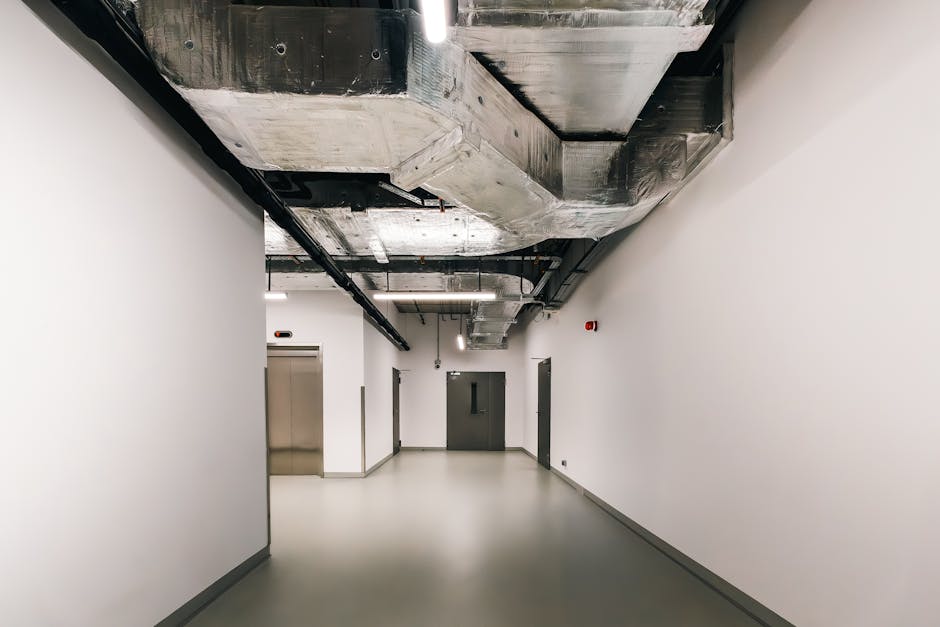

_11zon%20(1).webp)





